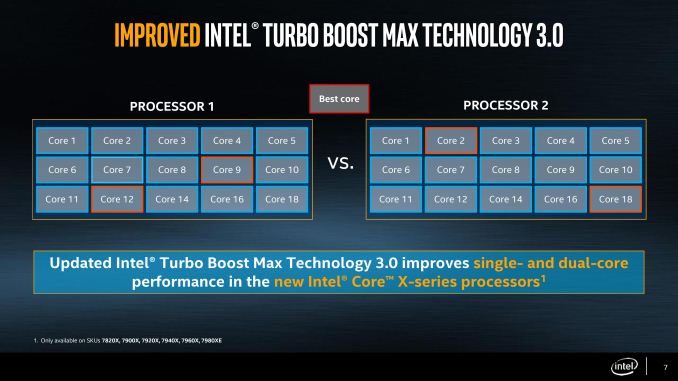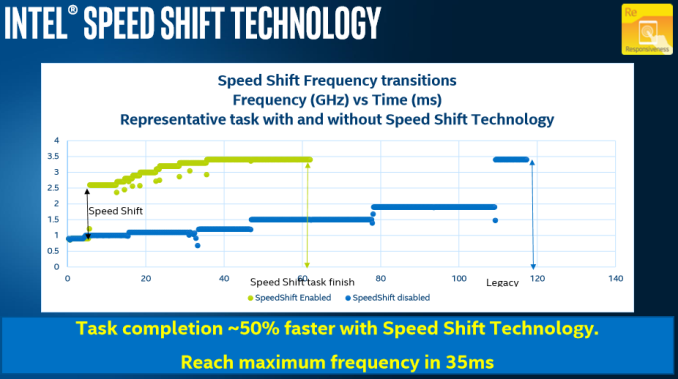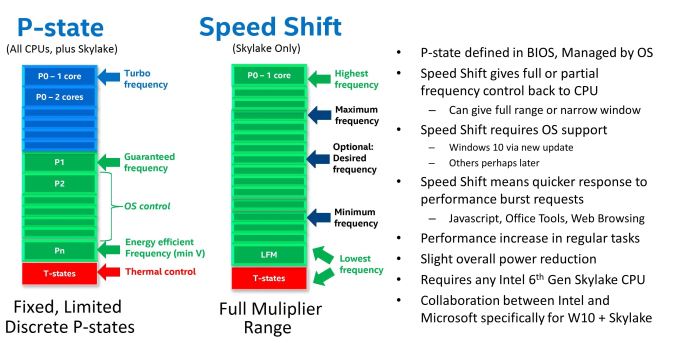The Intel Skylake-X Review: Core i9 7900X, i7 7820X and i7 7800X Tested
by Ian Cutress on June 19, 2017 9:01 AM ESTFavored Core
For Broadwell-E, the last generation of Intel’s HEDT platform, we were introduced to the term ‘Favored Core’, which was given the title of Turbo Boost Max 3.0. The idea here is that each piece of silicon that comes off of the production line is different (which is then binned to match to a SKU), but within a piece of silicon the cores themselves will have different frequency and voltage characteristics. The one core that is determined to be the best is called the ‘Favored Core’, and when Intel’s Windows 10 driver and software were in place, single threaded workloads were moved to this favored core to run faster.
In theory, it was good – a step above the generic Turbo Boost 2.0 and offered an extra 100-200 MHz for single threaded applications. In practice, it was flawed: motherboard manufacturers didn’t support it, or they had it disabled in the BIOS by default. Users had to install the drivers and software as well – without the combination of all of these at work, the favored core feature didn’t work at all.
Intel is changing the feature for Skylake-X, with an upgrade and for ease-of-use. The driver and software are now part of Windows updates, so users will get them automatically (if you don’t want it, you have to disable it manually). With Skylake-X, instead of one core being the favored core, there are two cores in this family. As a result, two apps can be run at the higher frequency, or one app that needs two cores can participate.
Speed Shift
In Skylake-S, the processor has been designed in a way that with the right commands, the OS can hand control of the frequency and voltage back to the processor. Intel called this technology 'Speed Shift'. We’ve discussed Speed Shift before in the Skylake architecture analysis, and it now comes to Skylake-X. One of the requirements for Speed Shift is that it requires operating system support to be able to hand over control of the processor performance to the CPU, and Intel has had to work with Microsoft in order to get this functionality enabled in Windows 10.
Compared to Speed Step / P-state transitions, Intel's new Speed Shift terminology changes the game by having the operating system relinquish some or all control of the P-States, and handing that control off to the processor. This has a couple of noticeable benefits. First, it is much faster for the processor to control the ramp up and down in frequency, compared to OS control. Second, the processor has much finer control over its states, allowing it to choose the most optimum performance level for a given task, and therefore using less energy as a result. Specific jumps in frequency are reduced to around 1ms with Speed Shift's CPU control from 20-30 ms on OS control, and going from an efficient power state to maximum performance can be done in around 35 ms, compared to around 100 ms with the legacy implementation. As seen in the images below, neither technology can jump from low to high instantly, because to maintain data coherency through frequency/voltage changes there is an element of gradient as data is realigned.
The ability to quickly ramp up performance is done to increase overall responsiveness of the system, rather than linger at lower frequencies waiting for OS to pass commands through a translation layer. Speed Shift cannot increase absolute maximum performance, but on short workloads that require a brief burst of performance, it can make a big difference in how quickly that task gets done. Ultimately, much of what we do falls more into this category, such as web browsing or office work. As an example, web browsing is all about getting the page loaded quickly, and then getting the processor back down to idle.
Again, Speed Shift is something that needs to be enabled on all levels - CPU, OS, driver, and motherboard BIOS. It has come to light that some motherboard manufacturers are disabling Speed Shift on desktops by default, negating the feature. In the BIOS is it labeled either as Speed Shift or Hardware P-States, and sometimes even has non-descript options. Unfortunately, a combination of this and other issues has led to a small problem on X299 motherboards.
X299 Motherboards
When we started testing for this review, the main instructions we were given was that when changing between Skylake-X and Kaby Lake-X processors, be sure to remove AC power and hold the reset BIOS button for 30 seconds. This comes down to an issue with supporting both sets of CPUs at once: Skylake-X features some form of integrated voltage regulator (somewhat like the FIVR on Broadwell), whereas Kaby Lake-X is more motherboard controlled. As a result, some of the voltages going in to the CPU, if configured incorrectly, can cause damage. This is where I say I broke a CPU: our Kaby Lake-X Core i7 died on the test bed. We are told that in the future there should be a way to switch between the two without having this issue, but there are some other issues as well.
After speaking with a number of journalists in my close circle, it was clear that some of the GPU testing was not reflective of where the processors sat in the product stack. Some results were 25-50% worse than we expected for Skylake-X (Kaby Lake-X seemingly unaffected), scoring disastrously low frame rates. This was worrying.
Speaking with the motherboard manufacturers, it's coming down to a few issues: managing the mesh frequency (and if the mesh frequency has a turbo), controlling turbo modes, and controlling features like Speed Shift. 'Controlling' in this case can mean boosting voltages to support it better, overriding the default behavior for 'performance' which works on some tests but not others, or disabling the feature completely.
We were still getting new BIOSes two days before launch, right when I need to fly half-way across the world to cover other events. Even retesting the latest BIOS we had for the boards we had, there still seems to be an underlying issue with either the games or the power management involved. This isn't necessarily a code optimization issue for the games themselves: the base microarchitecture on the CPU is still the same with a slight cache adjustment, so if a Skylake-X starts performing below an old Sandy Bridge Core i3, it's not on the game.
We're still waiting to hear for BIOS updates, or reasons why this is the case. Some games are affected a lot, others not at all. Any game we are testing which ends up being GPU limited is unaffected, showing that this is a CPU issue.













264 Comments
View All Comments
halcyon - Monday, June 19, 2017 - link
Thank you for the review. The AVX512 situation was a bit unclear. Which models have which AVX512 support of the now released chips (and the future, yet to be released chips). It would be interesting to see AVX512 specific article once the chips are out and we have (hopefully) some useful AVX512-optimized software (like encoding).For myself, decision is easy now to postpone, until ThreadRipper is out. The thermals are just out of whack and for my workloads, the price is not justified. Here's hoping Threadripper can deliver more for same price or less.
Bulat Ziganshin - Monday, June 19, 2017 - link
all skl-x has avx-512 support. i9 cpus has double fma512 engines, but as i guess - that's only difference, i.e. remaining 512-bit commands (such as integer operations) will have the same throughput on i7 and i9but i may be wrong and it will be really very ibteresting to check throughput of all other operatins. probably Anand can't do that and we will need to wait until Agner Fog will reach these spus
halcyon - Monday, June 19, 2017 - link
Thanks. Many questions remain: AVX512F vs AVX512BW, which are supported now, which in the future? What is the difference? How does it compare to Knights Landing? Are number of AVX units tied to number of cores? What is the speed differential in AVX512 loads? What is the oc limitation from AVX512 support? etc.nevcairiel - Monday, June 19, 2017 - link
Those Knights Landing/Knights Mill specific AVX512 instructions are actually very specific to the work-loads you would see on such a specialized CPU. The instructions chosen for Skylake-X and future Cannon Lake more closely match what we already know from AVX/AVX2.For the "types" of AVX512, basically its split into several sub-instruction sets, all containing different instructions. AVX512 will always include F, because thats the basis for everything (instruction encoding, 512-bit registers, etc). BW/DQ include the basic instructions we know from AVX/AVX2, just for 512-bit registers. SKL-X supports all of F, CD, BW, DQ, VL.
Wikipedia on AVX-512 has some more info on the different feature sets of AVX-512:
https://en.wikipedia.org/wiki/AVX-512
Its generally safe to just ignore the Knights Landing specific instructions. They are very specific to the workloads on those systems. The AVX-512 subset used for Xeon "Purley" and SKL-X is more inline with the AVX/AVX2 instructions we had before - just bigger.
For software, x264 for example already got some AVX512 optimizations over the recent weeks, it might be interesting to test how much that helps once all the launch dust settles.
halcyon - Tuesday, June 20, 2017 - link
Thank you very much!satai - Monday, June 19, 2017 - link
Any idea, why is Intel so much better at Chrome compilation?IanHagen - Monday, June 19, 2017 - link
I'd like to know that as well. Ryzen does particularly fine compiling the Linux Kernel, for example, as seen in: http://www.phoronix.com/scan.php?page=article&...tamalero - Monday, June 19, 2017 - link
Optimizations?I still remember when Intel actively paid some software developers to block multicore and threading on AMD chips to boast about "more performance" during the athlon X2 days.
johnp_ - Tuesday, June 20, 2017 - link
It's just the enterprise parts. Kaby Lake S is behind Ryzen:http://www.anandtech.com/show/11244/the-amd-ryzen-...
Gothmoth - Monday, June 19, 2017 - link
if powerdraw and heat would not be so crazy i would buy the 8 core today.but more than the price these heat issues are a concern for me.. i like my systems to be quiet....